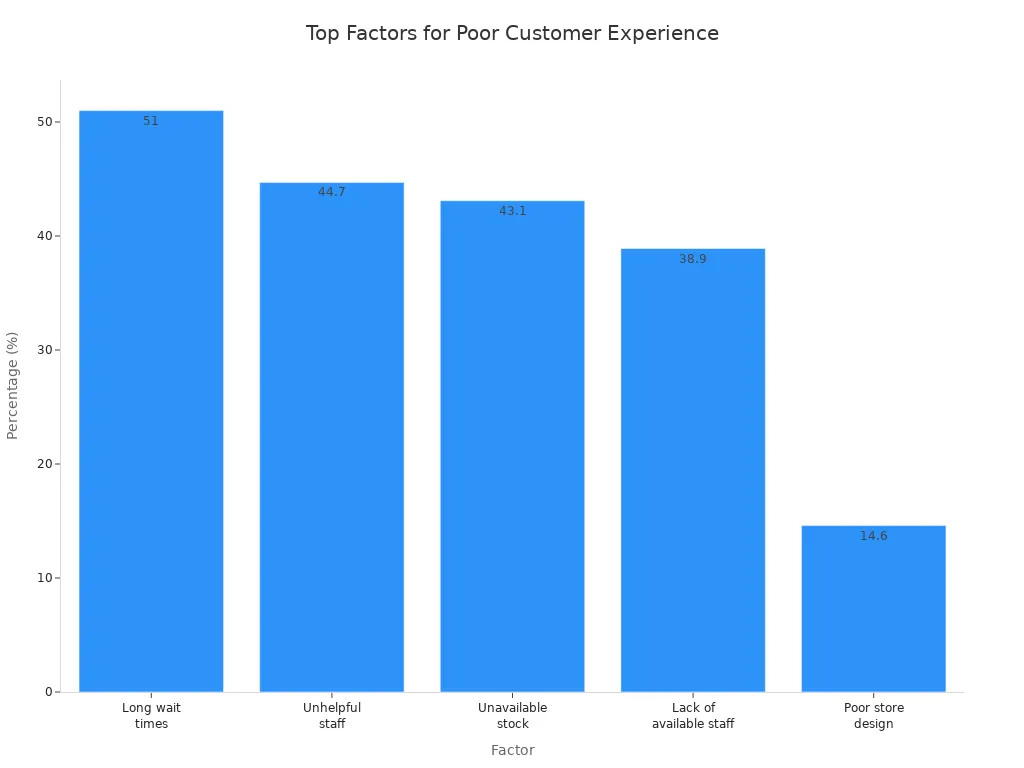Retail Operations

Retail Operations include the daily activities, systems, and processes that help your store run smoothly. You need to manage inventory, sales, customer service, product listings, advertising, supply chain, and order fulfillment. These tasks shape the shopping experience and keep your business profitable. When you handle them well, you boost customer satisfaction. For example, accurate order fulfillment and reliable mobile apps improve scores, while fragmented integration and slow digital processes lower satisfaction.
Challenge | Impact on Customer Satisfaction |
|---|---|
Fragmented Omnichannel Integration | Leads to mismatched pricing and inventory issues, frustrating customers who expect consistency across channels. |
Lack of Personalization | Customers feel undervalued when brands fail to recognize their preferences, impacting their overall satisfaction. |
Slow Adoption of Digital Solutions | Outdated processes result in long wait times and inconvenience, contributing to customer frustration and dissatisfaction. |
Key Takeaways
Effective retail operations create a smooth shopping experience. Focus on managing inventory, customer service, and order fulfillment to boost customer satisfaction.
Utilize technology and automation to streamline processes. Automated systems reduce errors and save time, allowing staff to focus on more complex tasks.
Train your staff regularly to improve service quality. Well-trained employees engage customers better and build loyalty, leading to repeat business.
Adopt data analytics to make informed decisions. Understanding customer behavior helps optimize inventory and marketing strategies, increasing profits.
Prioritize customer feedback and personalization. Listening to customers and addressing their needs fosters loyalty and encourages them to return.
Retail Operations Overview

Definition
You can think of retail operations as the backbone of any store, whether you sell online or in a physical location. Retail operations include all the systems and processes that help your business run every day. These systems have changed a lot with the rise of e-commerce. Today, you need to blend online and offline shopping experiences. Many stores now use multi-channel strategies. This means you can shop in a store, on a website, or even through a mobile app. Retailers must keep up with these changes to meet what customers want.
Here are some of the most common systems and processes you will find in modern retail operations:
Order Fulfillment
Supply Chain Management
Technology Integration
Employee Management
Customer Relationship Management
Data-Driven Decision Making
Standard Operating Procedures (SOPs)
Marketing and Promotions
Financial Management
Security and Compliance
Continuous Improvement and Innovation
You will also see stores automate inventory, streamline checkout, and use real-time reporting. Many retailers now centralize customer information and standardize daily procedures. These steps help you keep your store organized and efficient.
Importance
Retail operations play a key role in your business success. When you manage these operations well, you create a smooth shopping experience for your customers. You also keep your business profitable and ready to grow. Research shows that effective retail operations help you face new challenges and improve your store’s performance.
Key Insights | Description |
|---|---|
Studies show that knowing your challenges is crucial for operational success. | |
Organizational Performance Metrics | Good operations link directly to better business results. |
You can see that strong retail operations help you solve problems, measure your progress, and adapt to changes in the market. By focusing on these areas, you set your business up for long-term success.
Key Elements
Inventory Management
You need to keep track of every product in your store. Inventory management helps you know what you have, what you need, and when to restock. This process uses tools and systems to control your stocked goods. When you use a point-of-sale (POS) system, you can build a dashboard to track key performance indicators (KPIs). This helps you make smart decisions about your products.
Proper inventory management makes sure you have the right products in the right place at the right time.
You avoid running out of popular items or having too much of something that does not sell.
Automated systems like Cin7 Omni help small and medium businesses manage stock, fulfill orders, and track sales. These systems offer flexible dashboards and reporting tools.
Tip: Good inventory management balances supply and demand, which keeps your customers happy and your costs low.
Product Listing
Product listing is how you show your products to customers, both online and in-store. You need clear titles, detailed descriptions, and high-quality images. When you do this well, customers find what they want faster and are more likely to buy.
On your website, strong search features help customers find products quickly.
Personalized search results based on browsing history can increase the chance of a sale.
You should watch metrics like zero-results searches and click-through rates to learn what your customers want.
Description | |
|---|---|
Craft Titles That Get Found Everywhere | Use keywords and follow channel rules for better visibility. |
Write Descriptions That Turn Browsers into Buyers | Highlight benefits and use action words to boost sales. |
Show Off with High-Quality Images | Use clear, high-resolution photos to build trust. |
Price Competitively and Consistently | Research the market and keep prices steady across channels. |
Build Trust with Reviews and Ratings | Encourage feedback and respond to reviews. |
Use Tools and Data to Continuously Improve | Automate product info and keep listings up to date. |
Advertising
Advertising helps you reach new customers and remind current ones about your store. You can use email, social media, and other channels to share your message. Email marketing stands out, giving you $45 for every $1 you spend.
Marketing Channel | ROI |
|---|---|
Email Marketing |
Campaigns that use three or more channels get an average engagement rate of 18.96%. This is much higher than the 5.4% rate for single-channel campaigns. Omnichannel marketing helps you connect with more people and keeps them interested in your brand. Companies like Nike and Glossier show how creative, customer-focused advertising can build strong relationships.
Supply Chain
The supply chain covers everything from getting products from suppliers to delivering them to your store or customer. Efficient supply chain management saves money and keeps customers satisfied. When you manage your supply chain well, you meet customer demand without raising costs.
A strong supply chain increases output and revenue while lowering operating costs.
Using item-level RFID technology gives you better visibility and control over your stock.
Reducing extra inventory cuts down on manufacturing, storage, and shipping costs.
Building resilience into your supply chain can boost sales by 3% to 7% and improve cash flow by 15%.
Note: Many retailers face challenges like tight profit margins, meeting customer expectations, and integrating multiple channels. You need to address these issues to keep your business running smoothly.
Order Fulfillment
Order fulfillment is how you get products to your customers after they buy them. Fast and accurate fulfillment keeps customers coming back. You can use technology to speed up this process.
AI-powered robots help pick and pack orders quickly.
Automated systems and pick-to-light technology reduce mistakes.
Voice picking lets workers use both hands and follow real-time instructions.
Warehouse Management Systems (WMS) organize tasks and give instant feedback.
Advanced analytics and electronic data exchange improve workflow and communication.
Tip: The right technology increases productivity and makes sure customers get their orders on time.
Customer Service
Customer service is the support you give before, during, and after a sale. Good service builds trust and encourages customers to shop with you again. In 2024, 45% of shoppers switched brands because of poor service. Almost half of customers leave if they feel their problems are not handled well.
Responsive and helpful service makes customers feel valued.
When you solve issues quickly, you build loyalty and increase repeat purchases.
Remember: Customer service is a key part of Retail Operations. It can make or break your relationship with shoppers.
Common Challenges

Inventory Issues
You face many inventory challenges in retail. Poor inventory management often leads to mismatches between what you have and what customers want. Problems like shoplifting, employee theft, and administrative errors can shrink your stock. Manual data entry mistakes, scan errors, and receiving errors also cause trouble. These issues can result in out-of-stock or overstock situations. Inaccurate inventory can lead to a 30% loss in revenue. In 2023, out-of-stocks cost retailers about $1.2 trillion, while overstocks added $562 billion in losses. Research shows that 60% of retail SKUs are inaccurate, which can hurt your profits and disrupt your business.
Staffing
Staffing remains a big challenge in retail. The average turnover rate is about 60%, and part-time hourly workers leave even more often. When you struggle to keep staff, service quality drops. You may need to reduce store hours or limit services. This can frustrate customers and make it hard to run your store smoothly. Empowering employees and offering incentives can help, but finding and keeping good staff is still tough.
Technology
Technology can help or hurt your business. Many retailers struggle with outdated systems. Old POS or order management systems slow down transactions and increase errors. You may lose up to $30,000 a year from lost efficiency and extra maintenance. Outdated technology also makes your business more vulnerable to cyberattacks and inventory mistakes. Here are some common technology challenges:
Challenge | Impact |
|---|---|
Inventory Management and Demand Forecasting | Lost sales, higher costs, unhappy customers |
Keeping Up with Rapidly Changing Technology | Competitors move ahead with better tools |
Data Integration and Management | Inconsistent experiences and missed opportunities |
Omnichannel Integration | Stock issues, delays, customer frustration |
Cybersecurity and Data Privacy | Financial losses, reputational damage, regulatory penalties |
Customer Experience
Customer experience shapes your success. Long wait times, unhelpful staff, and unavailable stock top the list of complaints. Lack of available staff and poor store design also matter. See the chart below for the leading causes of poor customer experience:

You need to address these issues to keep shoppers happy and loyal.
Financial Control
Financial control problems can threaten your business. You might not have enough cash to pay debts on time. Cash can get tied up in unsold stock. Increased debtor days and bad debt can hurt your cash flow. If you manage your business by cash alone, you risk missing refunds or rebates. Poor financial control can lead to lower profits and more questions from auditors. Strong financial management is key to healthy Retail Operations.
Optimization Strategies
Technology & Automation
You can boost Retail Operations by using technology and automation. Automated systems help you track inventory, process orders, and manage workflows. These tools reduce human error and save time. You can use robotic automation in warehouses to speed up picking and packing. Workflow automation improves risk management and order fulfillment. Analytics automation gives you real-time data for better decisions.
Automation Type | Benefits |
|---|---|
Workflow/process automation | Reduces errors and improves order fulfillment |
Analytics automation | Provides real-time insights for smarter choices |
Order fulfillment automation | Streamlines delivery and boosts customer experience |
Inventory management automation | Prevents overstocking and shortages |
Robotic automation | Increases speed and accuracy in warehouses |
Tip: Automation lets your staff focus on complex tasks and helps you scale your business.
Data Analytics
You can use data analytics to make smarter decisions. Analytics show you what customers buy, when they shop, and how they behave. Retailers who use advanced analytics see higher profits and better customer service. For example, Amazon’s recommendation engine drives 35% of its sales by using customer data. Analytics also help you manage inventory, set prices, and plan marketing. Companies using data analytics often reduce labor costs and improve customer satisfaction.
Data analytics can increase marketing ROI by 15-20%.
You can optimize workforce management and improve operational efficiency.
Staff Training
Training your staff improves Retail Operations. Sales training helps employees engage customers. Customer service training builds loyalty. Digital training platforms let your team learn at their own pace. Tomlinson’s, a pet supply retailer, cut training time by 32% after switching to a digital POS system. Standardized onboarding and centralized training content keep your team consistent and reduce turnover.
Use digital courses for flexible learning.
Create modular programs for safety and compliance.
Customer Focus
You should always put your customers first. Listen to their feedback and solve problems quickly. Personalized service makes shoppers feel valued. Use CRM software and chatbots to answer questions fast. Happy customers return and recommend your store to others.
Note: Strong customer focus leads to loyalty and repeat business.
Process Improvement
You can improve your processes by adopting proven methods. Six Sigma reduces defects and boosts quality. Total Quality Management focuses on continuous improvement and customer satisfaction. Lean Manufacturing helps you cut waste and work more efficiently.
Methodology | Focus Areas |
|---|---|
Six Sigma | Reducing defects and improving quality |
Total Quality Management | Continuous improvement and customer satisfaction |
Lean Manufacturing | Reducing waste and enhancing efficiency |
Retail Operations help you run your store efficiently and keep customers happy. You need to improve your processes often to stay ahead.
Competition pushes you to offer better products and services.
High employee turnover means you must train your team well.
New technology helps you work faster and smarter.
Following rules protects your business and your brand.
You can boost your results by streamlining tasks, focusing on customer experience, and encouraging your team to learn new skills. Start by reviewing your current operations and choose one area to improve today.
FAQ
What is the most important part of retail operations?
You need to focus on inventory management. It helps you keep the right products in stock. Good inventory control prevents lost sales and extra costs. This step supports every other part of your store.
How can you improve customer service in retail?
You can train your staff to listen and respond quickly. Use customer feedback to find problems. Offer help in person, online, or by phone. Friendly service makes shoppers want to return.
Why should you use technology in retail operations?
Technology saves you time and reduces mistakes. You can track sales, manage stock, and help customers faster. Tools like POS systems and automation make your store run smoothly.
What is omnichannel retailing?
Omnichannel retailing lets customers shop in your store, on your website, or through an app. You give them a seamless experience. Prices, products, and service stay the same across all channels.
How do you handle out-of-stock products?
You can use real-time inventory tracking. Set up alerts for low stock. Tell customers when items will return. Offer similar products if possible. This keeps shoppers happy and reduces lost sales.
See Also
Understanding Essential Corner Store Concepts and Their Importance
Discovering Sensi Retail: A Community-Focused Cannabis Shop in LA
The Growth of AI-Driven Corner Stores: Key Insights for Retailers
Starting an AI-Enhanced Corner Store on a Budget
Grocery Vending Machines Transforming Access to Retail Services
